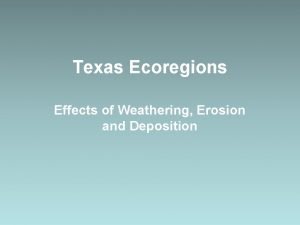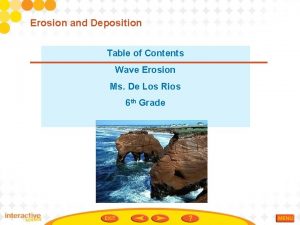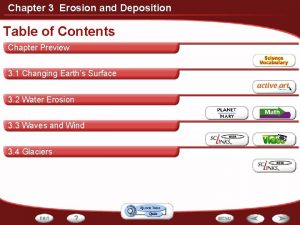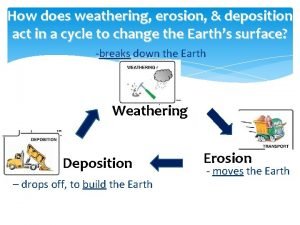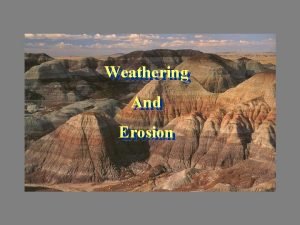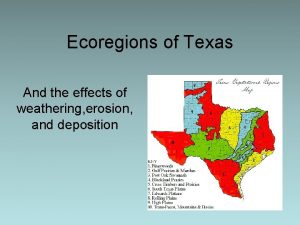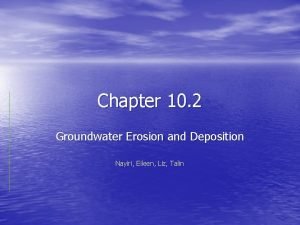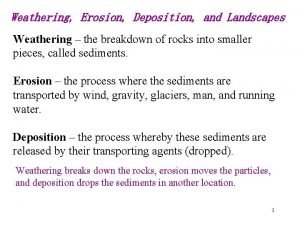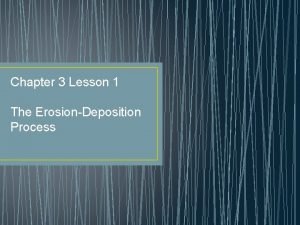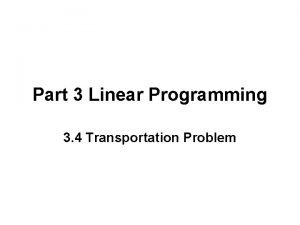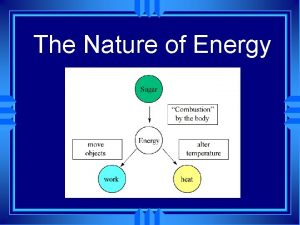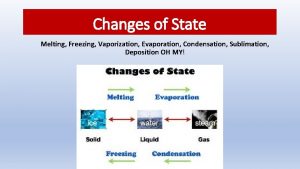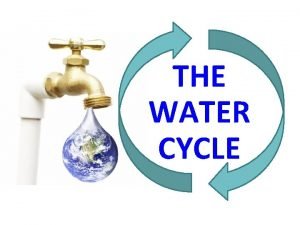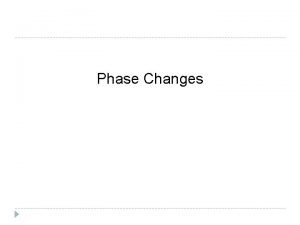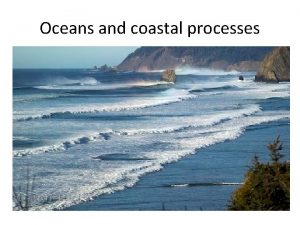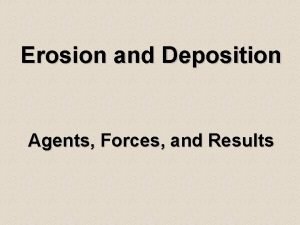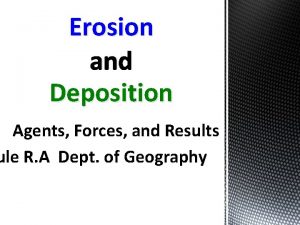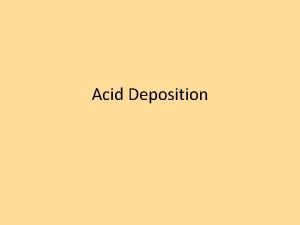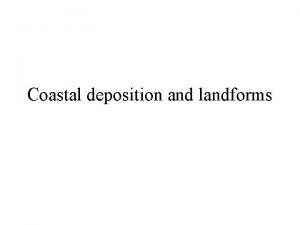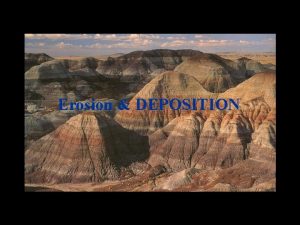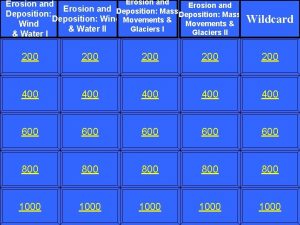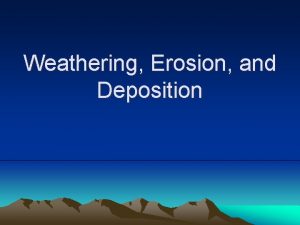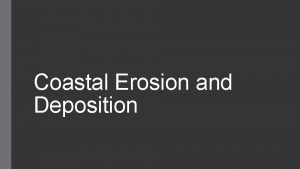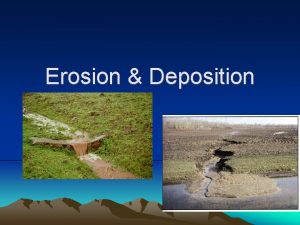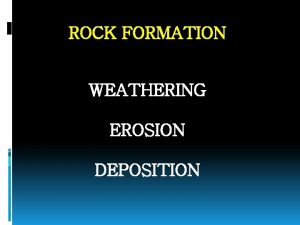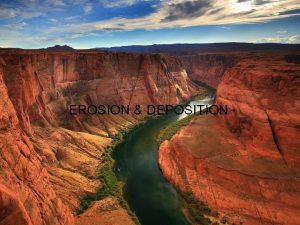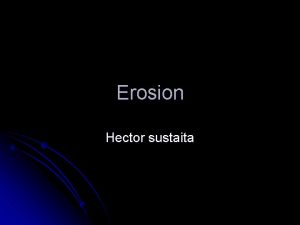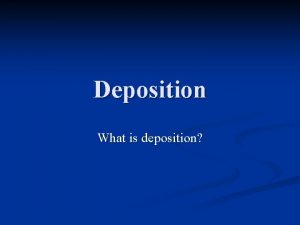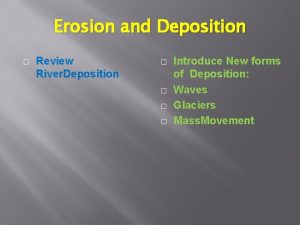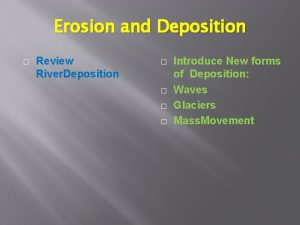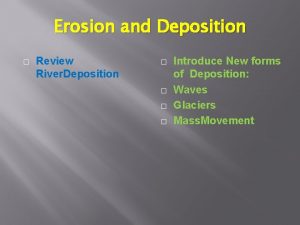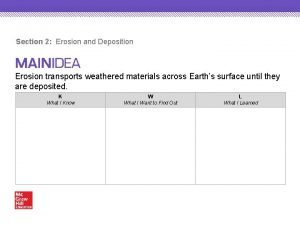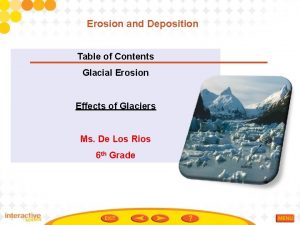Erosion Transportation and Deposition Define erosion transportation and



































- Slides: 35

Erosion, Transportation and Deposition Define erosion, transportation and deposition Understand how transportation works Analyse the features which are created because of deposition

Can you define any of these words? ? EROSION TRANSPORTATION DEPOSITION

Test your knowledge: Developing 1) Write a definition of the following key terms (you can do this independently or research it, obviously the answer is on the next slide if you struggle!): - Erosion - Transportation - Deposition

Define erosion, transportation and deposition EROSION You should have known this one from our last few lessons! • Material being worn away from the coast by the waves TRANSPORTATION • Eroded material being moved along the coast by the waves DEPOSITION • Material being deposited (dropped off) further down the coast by (constructive) waves

Transportation • What do you already know about how waves move on and off the beach? THINK: Waves Swash Backwash

SWASH The water rushing up the beach. BACKWASH The water rolling back down the beach. Swash Backwash

Test your knowledge: Secure 2) Try to explain what could have happened here: • When I was younger I went on holiday to Wales with my Gran, Grandad and my older brother, Andy. • One day we were at the beach and Andy took off his favourite Man United shorts so he could go swimming in the sea… (don’t worry- he had swim shorts on underneath!) • Unfortunately, the shorts disappeared and Andy was devasted! • However, we all visited the beach later that day and, to Andy’s great surprise and relief, the shorts turned up about a mile down the beach from where we had been earlier in the day… • How do you think they got there?

How did it get here?

Swash How did it get here? Backwash

This process is ‘transportation’, because material is being transported! It’s known as ‘Longshore drift’ Direction of longshore drift movement Backwash is always at right angles to the beach swash Backwash Direction of prevailing wind

Test your knowledge: Secure 3) Draw your own diagram to show longshore drift

Deposition • When the sea loses energy, it drops the material it has been carrying. This is called deposition. • How can you relate this to your previous knowledge? – What do you know about waves? – What type of waves create deposition? – What part of the waves needs to be stronger for deposition to happen?

Deposition • When the sea loses energy, it drops the material it has been carrying. This is called deposition. • How can you relate this to your previous knowledge? What do you know about waves? There are two types- constructive and destructive What type of waves create deposition? Constructive waves create deposition because they leave material on the beach – What part of the waves needs to be stronger for deposition to happen? – The swash needs to be bigger as this pushes material onto the beach – –

Explain why deposition is more likely to occur in the following situations: 1. 2. 3. 4. Waves enter an area of shallow water. Waves enter a sheltered area, eg a bay. There is little wind. There is more erosion which means a good supply of material

Explain why deposition is more likely to occur in the following situations: Waves enter an area of shallow water. Shallow water will have less energy so the swash will be bigger than the backwash (creating more deposition of sand onto the beach) Waves enter a sheltered area, eg a bay. Sheltered areas are protected from the wind so the waves will be much smaller, smaller waves are likely to be constructive waves There is little wind Wind creates the type of wave, constructive wanes are needed for deposition and this will happen if we don’t have much wind There is more erosion which means a good supply of material If there is more material in the water the is more material to be deposited onto the beach.

• So, when we have bays, lots of deposition is likely to occur. • Not only will this create a beach inside the bay, but it will create a new features called spits and bars. • Watch the following animation to see how they are created…


What this looks like in real life: Look how the material (sand) has been deposited so much that over time it has built a sort of sand hill which eventually shows above the waters surface. This is what we call a spit. When the spit goes all the way from one headland to another (totally covering the bay) we call this a bar.

Test your knowledge: Secure+ 4) Try to draw your own diagram to show a spit and bar : – It could be a diagram for each or a single diagram showing both – Have a go at created your own but if you’re struggling look at the next slide for some ideas – When you’ve finished, check on the next slide to make sure your diagram is accurate.

Longshore drift Headland Spit Deposited sand builds up over time and spit gets bigger

Finally…. If you think the picture is a Spit do the LIGHTNING BOLT SPIT If you think the picture is a Bar do the MO BOT BAR

SPIT BAR

SPIT It doesn’t go all the way along from one headland to another so it is a spit!

SPIT BAR

It connects the two headlands and totally cuts the bay off meaning it’s a bar! BAR

SPIT BAR

It connects the two headlands and totally cuts the bay off meaning it’s a bar! BAR

SPIT BAR

SPIT It doesn’t go all the way along from one headland to another so it is a spit!

SPIT BAR

Even though we can’t see the bay behind, it has to be a bar because it connects two bits of land. BAR

BAR SPIT

It doesn’t go all the way along from one headland to another so it is a spit! SPIT

SPIT BAR

It connects the two headlands and totally cuts the bay off meaning it’s a bar! BAR
 Erosion in piney woods
Erosion in piney woods Weathering in the piney woods
Weathering in the piney woods Deposition in trans pecos
Deposition in trans pecos An area of wave-washed sediment along a coast is a(n)
An area of wave-washed sediment along a coast is a(n) The term geologists use for underground water is
The term geologists use for underground water is Weathering erosion and deposition
Weathering erosion and deposition Deposition science
Deposition science Difference between erosion and deposition
Difference between erosion and deposition Diagram of erosion and deposition
Diagram of erosion and deposition Piney woods texas ecoregions
Piney woods texas ecoregions Groundwater erosion and deposition
Groundwater erosion and deposition Detachment in soil erosion
Detachment in soil erosion Weathering vs erosion vs deposition
Weathering vs erosion vs deposition The erosion-deposition process
The erosion-deposition process Control measures of soil erosion slideshare
Control measures of soil erosion slideshare Define triangular basis in transportation problem
Define triangular basis in transportation problem Balanced assignment problem
Balanced assignment problem Sublimation examples
Sublimation examples Phase change for condensation
Phase change for condensation Water table illustration
Water table illustration Deposition funnel technique
Deposition funnel technique 6 common phase changes
6 common phase changes Deposition phase change
Deposition phase change Oceans cover approximately
Oceans cover approximately Electrochemical deposition
Electrochemical deposition Fused deposition modeling history
Fused deposition modeling history What causes deposition
What causes deposition Deposition agents
Deposition agents Precision liquid deposition solution
Precision liquid deposition solution Are canyons constructive or destructive
Are canyons constructive or destructive Atomic layer deposition for semiconductors
Atomic layer deposition for semiconductors What causes acid deposition
What causes acid deposition Diffusion limited
Diffusion limited Weathering and erosion virtual field trip
Weathering and erosion virtual field trip Coastal deposition
Coastal deposition Electrospark deposition
Electrospark deposition

